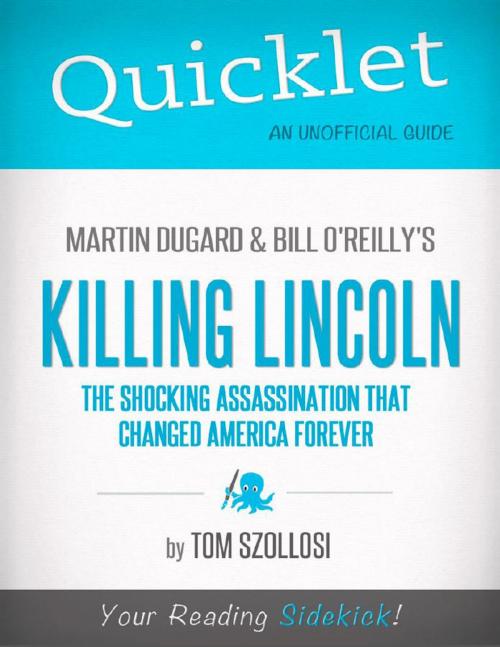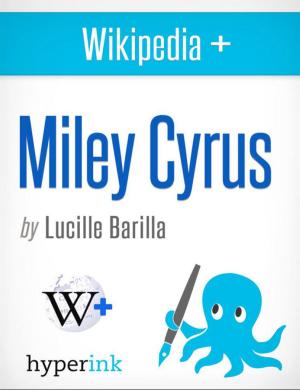Quicklet on Martin Dugard and Bill O'Reilly's Killing Lincoln: The Shocking Assassination that Changed America Forever (CliffNotes-like Summary and Analysis): Chapter-by-Chapter Summary and Commentary
Nonfiction, History, Reference, Art & Architecture, General Art| Author: | Tom Szollosi | ISBN: | 9781614646471 |
| Publisher: | Hyperink | Publication: | July 30, 2012 |
| Imprint: | Hyperink - Killing Lincoln Quicklet | Language: | English |
| Author: | Tom Szollosi |
| ISBN: | 9781614646471 |
| Publisher: | Hyperink |
| Publication: | July 30, 2012 |
| Imprint: | Hyperink - Killing Lincoln Quicklet |
| Language: | English |
ABOUT THE BOOK
“The man with six weeks to live is anxious. He furls his brow, as he does countless times each day, and walks out of the Capitol Building, which is nearing completion. He is exhausted, almost numb.”
It is a rare to find a historical work written in the present tense, but in Killing Lincoln: The Shocking Assassination that Changed America Forever, that is what Martin Dugard and Bill O’Reilly have done. In a USA Today interview, “O’Reilly says Dugard did the research on the Lincoln book, and ‘I wrote it. A true collaboration.’” While the book is light on attribution, it is a compelling and fast read. O’Reilly says he “wanted [Killing Lincoln] to read like a thriller... for people who are not particularly interested in history, and to show what true leaders are like.”
It does indeed read like a thriller. Using the present tense gives the work immediacy and heightens pace, but at times also feels intrusive because the subject matter so clearly isn’t immediate today. A historical overview might be better served by the good old past tense. Nevertheless, the book brims with conspiracy facts, touching on mysteries never conclusively proven wrong–although they’ve also never been proven right.
Most notable of these theories is one centering on Secretary of War Edwin Stanton, who was in possession of assassin John Wilkes Booth’s diary, thanks to the work of private investigator Lafayette Baker. Baker was personally hired by Stanton and gave him the diary, which he found in Booth’s hotel room. Furthermore, when Stanton finally released the diary, 18 pages were missing, raising many an eyebrow. The Stanton theory has, as the authors admit, been “repudiated and dismissed by the vast majority of trained historians.”
EXCERPT FROM THE BOOK
“Lincoln strides purposefully back and forth, unprotected and unafraid, as vulnerable as a man can be to sniper fire, the bombardment serving as the perfect distraction from his considerable worries. When will this war ever end?”
Abraham Lincoln was a man racing his fate. He knew it, even as he gave his second inaugural speech before 50,000 drenched citizens. Among them was John Wilkes Booth, a young, handsome, famous actor who had originally planned to kidnap the president, but instead decided to murder him, along with General Ulysses S. Grant, Secretary of State Seward, and Vice President Andrew Johnson.
On April 1, 1865, Lincoln awaited news from Grant, whose Union Army was engaged against General Robert E. Lee’s Army of Northern Virginia. A succession of horrific battles would end in Lee’s surrender when his ravaged army could no longer match the vast Union force. Lincoln’s terms of surrender were lenient, despite calls for vengeance.
Amid Washington celebration, Lincoln became Booth’s obsession. He learned that the President and Mrs. Lincoln would attend “Our American Cousin” at Ford’s Theatre, one of Booth’s favorite haunts, on Good Friday. After a nerve-wracking day of preparation, he was a coiled spring. His co-conspirators knew their roles–Lewis Powell would kill Secretary of State Seward, George Atzerodt would kill Vice President Andrew Johnson, while Booth shot Lincoln and Grant, who would be with the President.
To Booth’s frustration, Grant left the capitol that afternoon. But the show went on. As Booth shot Lincoln, Powell slashed at Seward in his bed, where he was recovering from a carriage accident. But Powell had to literally hack his way through Seward’s son, daughter, and two others first. Amazingly, all in the house survived. Only William Bell, “a young black servant in a pressed white coat,” who answered the door...
...buy the book to continue reading!
ABOUT THE BOOK
“The man with six weeks to live is anxious. He furls his brow, as he does countless times each day, and walks out of the Capitol Building, which is nearing completion. He is exhausted, almost numb.”
It is a rare to find a historical work written in the present tense, but in Killing Lincoln: The Shocking Assassination that Changed America Forever, that is what Martin Dugard and Bill O’Reilly have done. In a USA Today interview, “O’Reilly says Dugard did the research on the Lincoln book, and ‘I wrote it. A true collaboration.’” While the book is light on attribution, it is a compelling and fast read. O’Reilly says he “wanted [Killing Lincoln] to read like a thriller... for people who are not particularly interested in history, and to show what true leaders are like.”
It does indeed read like a thriller. Using the present tense gives the work immediacy and heightens pace, but at times also feels intrusive because the subject matter so clearly isn’t immediate today. A historical overview might be better served by the good old past tense. Nevertheless, the book brims with conspiracy facts, touching on mysteries never conclusively proven wrong–although they’ve also never been proven right.
Most notable of these theories is one centering on Secretary of War Edwin Stanton, who was in possession of assassin John Wilkes Booth’s diary, thanks to the work of private investigator Lafayette Baker. Baker was personally hired by Stanton and gave him the diary, which he found in Booth’s hotel room. Furthermore, when Stanton finally released the diary, 18 pages were missing, raising many an eyebrow. The Stanton theory has, as the authors admit, been “repudiated and dismissed by the vast majority of trained historians.”
EXCERPT FROM THE BOOK
“Lincoln strides purposefully back and forth, unprotected and unafraid, as vulnerable as a man can be to sniper fire, the bombardment serving as the perfect distraction from his considerable worries. When will this war ever end?”
Abraham Lincoln was a man racing his fate. He knew it, even as he gave his second inaugural speech before 50,000 drenched citizens. Among them was John Wilkes Booth, a young, handsome, famous actor who had originally planned to kidnap the president, but instead decided to murder him, along with General Ulysses S. Grant, Secretary of State Seward, and Vice President Andrew Johnson.
On April 1, 1865, Lincoln awaited news from Grant, whose Union Army was engaged against General Robert E. Lee’s Army of Northern Virginia. A succession of horrific battles would end in Lee’s surrender when his ravaged army could no longer match the vast Union force. Lincoln’s terms of surrender were lenient, despite calls for vengeance.
Amid Washington celebration, Lincoln became Booth’s obsession. He learned that the President and Mrs. Lincoln would attend “Our American Cousin” at Ford’s Theatre, one of Booth’s favorite haunts, on Good Friday. After a nerve-wracking day of preparation, he was a coiled spring. His co-conspirators knew their roles–Lewis Powell would kill Secretary of State Seward, George Atzerodt would kill Vice President Andrew Johnson, while Booth shot Lincoln and Grant, who would be with the President.
To Booth’s frustration, Grant left the capitol that afternoon. But the show went on. As Booth shot Lincoln, Powell slashed at Seward in his bed, where he was recovering from a carriage accident. But Powell had to literally hack his way through Seward’s son, daughter, and two others first. Amazingly, all in the house survived. Only William Bell, “a young black servant in a pressed white coat,” who answered the door...
...buy the book to continue reading!















